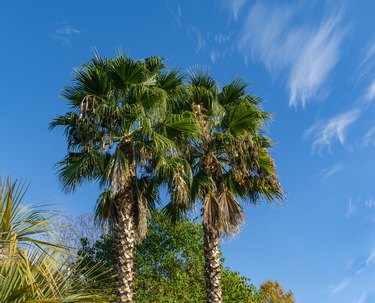
The Washingtonia genus of palm trees includes only two species; the Washington fan palm (Washingtonia robusta, USDA zones 9-11), which is also called the Mexican fan palm, and the California fan palm (W. filifera, zones 9-11). These trees are native to arid areas of California, Nevada, Arizona, Florida and northwestern Mexico, depending on the species.
These palm trees grow up to 100 feet tall (W. robusta) or 70 feet (W. filifera) and have lifespans of up to 100 years or more. They are cold hardy to around 18 degrees Fahrenheit, making them appropriate for gardens as far north as U.S. Department of Agriculture plant hardiness zone 9, which, because of the moderating influence of the Pacific Ocean, can stretch up the West Coast as far as Washington state, lending a certain aptness to the common name Washingtonia palm, which was actually named for George Washington.
Video of the Day
Video of the Day
Things You'll Need
How to Care for a Washingtonia Palm Tree
Step 1: Prepare the Planting Area
Prepare a planting area in full sun where your Washingtonia will be able to grow to 100 feet tall without hitting power lines or nearby buildings. Also allow room for this tree's 25 to 30 foot spread. Dig a planting hole at least twice the width but only as deep as your young tree's rootball, using a round-point shovel. Combine a ratio of 4-to-1 native soil to organic compost.
Step 2: Water the Palm
Water your new palm thoroughly with 4 to 5 gallons of water to drench the soil after planting it. Keep the soil moist, but not soggy, until the tree shows signs of new growth, which will be evident when small green fronds emerge from the growing tip of the tree. After two to three months, when the root system becomes established, limit the amount of water you give it because it is a desert plant. Reduce water further during winter.
Step 3: Fertilize Every Month
Fertilize your Washingtonia with a water-soluble fertilizer or granular, timed-release plant food that's formulated specifically for palms, according to soil-test recommendations. The fronds need nitrogen for effective photosynthesis and to maintain a green color, the roots need phosphorous for strength and to retain nutrients and the the entire plant needs potassium to help strengthen it and resist disease.
Step 4: Control Insect Pests
Control insect pests such as aphids, spider mites and mealy bugs by spraying your palm with water to dislodge these creatures as soon as possible after you notice them on your plant. Aphids can be green, pink, brown or black. They are normally about 1/16 inch long and favor the undersides of leaves. Spider mites announce their presence by spinning webs similar to spiders. Although the insects are tiny, watch for the webbing, which is the indication they exist. Mealy bugs are also small but are visible due to their fuzzy white appearance.
Step 5: Prune Brown Fronds
Prune brown fronds from the "skirt" at the base of your Washingtonia's foliage regularly because they are a fire hazard, which is increasingly a concern in its native desert habitat, where fires are becoming more common. Use a sharp tree saw or pole pruner and begin cutting on the top side of each frond as close to the trunk as possible without cutting into the trunk.